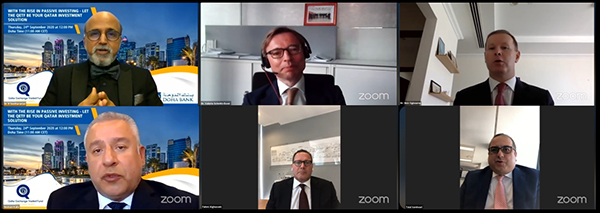Doha Bank QETF Webinar
QETF IS BIGGER OPPORTUNITY FOR INVESTORS

Doha Bank, in part of its ongoing webinar series, held an event to discuss ‘With the rise of Passive Investing – let the QETF be your Qatar investment solution’, on Thursday, 24 September 2020.
The panel was hosted and chaired by CEO of Doha Bank, Dr. R. Seetharaman who highlighted the challenges faced by the Global economy due to COVID-19. He emphasized, ‘that we should take efforts to come back to normalcy. The concerns of second wave of COVID-19 remain, medicine for the entire global population. He highlighted on key developments in Qatar which includes its airport, investment programme, SME sector development, food security, investment law, new property law and PPP law.’ Global ETFs has witnessed demand as investors prefer passive investment strategies. He mentioned on multiple occasions, ‘the country is poised to continue on a trajectory not seen by other emerging markets. In terms of potential future growth, Qatar stands out from the others and offer investors a number of opportunities to be had on the lead up to the FIFA World Cup 2022, and longer term - need to know that the QETF is a bigger opportunity for them.
The bank had a special guest panelist, the Managing Director and Head of Index Solutions for Credit Suisse Asset Management, Dr. Valerio Schmitz-Esser. He has been Head of Index Solutions for almost ten years with Credit Suisse and has witnessed a significant change in direction of inflows originating from passive investors. He stated, ‘that the group currently manages USD 151 billion in index funds, and our success has been derived by being able to design our index funds and ETFs to minimize the total cost of ownership for our investors. The objective is simple, replicate risk-return characteristics of the benchmark as accurately as possible.’
Talal Samhouri, Senior Portfolio Manager of Aventicum Capital Management Qatar presented the investment case for the QETF. Throughout the presentation he kept highlighting that the QETF is benchmarked to the QE Index, so for the investor that is not sure how to invest or what company to trade in the local market, he states, ‘it’s perfect for the long term investors to buy and hold the QETF, and reinvest their dividends. To be able to have the Qatar Index in your portfolio is difficult to replicate and costly to do so. He suggested that investors that did not know the market but still wanted to participate could earn index like returns by investing in the QETF.’ The QETF since listing has provided a total return of +24% (total return is price change plus dividend received), while the QE Index has produced a total return of +25% placing it in the top 10 best performing markets globally over the past 2 1/2years.
Nick Ogbourne, Manager of Product Development at the Qatar Stock Exchange moderated the ‘Sales & Trading Q&A’ portion of the webinar, where it was explained how to trade the QETF and which different strategies to employ. Dr. R. Seetharaman stated, ‘the QETF trades like all other listings, in that the investor requires an investor number from the Qatar Central Securities Depository and opening of an account with a licensed local broker. Once the investor has access, they can trade the QETF.’ Fahmi Alghussein, CEO of Aventicum Capital Management Qatar, added ‘institutions, corporates and individuals can transact directly with the QETF, by approaching the Founder, Doha Bank. Once approved as an Authorised Participant the investor can create and redeem units with the Fund, making this an attractive feature of the fund’. Talal Samhouri, also shared ‘that like the other listings the fund pays out a dividend annually and this year was the first listing in the history of the Qatar Stock Exchange to distribute their annual dividend over multiple installments, much like international and other regional markets. This allowed the fund to minimize the tracking difference while managing the fund during the dividend season.’ Dr. Valerio Schmitz-Esser shared that ‘ETFs should have a part in everyone’s portfolio as they offer lower volatility, easy access to the performance of the underlying index at a lesser cost, you receive income (in the case of the QETF 4% annually) and you can leverage on the market opportunities as you trade around other listings. This allows for a lower risk portfolio to be managed by adding the ETFs or in this case the QETF.’
For further information on the QETF and risks associated around investing, please be sure to visit the funds website www.qetf.com.qa
*************************************




